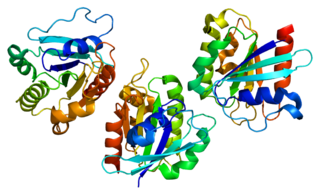
Zinc finger protein GLI3 is a protein that in humans is encoded by the GLI3 gene.

Integral membrane protein GPR155, also known as G protein-coupled receptor 155, is a protein that in humans is encoded by the GPR155 gene. Mutations in this gene may be associated with autism.

Probable G-protein coupled receptor 162 is a protein that in humans is encoded by the GPR162 gene.

Indian hedgehog homolog (Drosophila), also known as IHH, is a protein which in humans is encoded by the IHH gene. This cell signaling protein is in the hedgehog signaling pathway. The several mammalian variants of the Drosophila hedgehog gene (which was the first named) have been named after the various species of hedgehog; the Indian hedgehog is honored by this one. The gene is not specific to Indian hedgehogs.

WD repeat and SOCS box-containing protein 1 is a protein that in humans is encoded by the WSB1 gene.

Bardet–Biedl syndrome 5 protein is a protein that in humans is encoded by the BBS5 gene.

Ubiquitin-like modifier-activating enzyme 6 is a protein that in humans is encoded by the UBA6 gene.

ADP-ribosylation factor-like protein 6 is a protein that in humans is encoded by the ARL6 gene.

Cysteine-rich with EGF-like domain protein 1 is a protein that in humans is encoded by the CRELD1 gene.

Kinesin family member KIF18A is a human protein encoded by the KIF18A gene. It is part of the kinesin family of motor proteins.

RING finger protein 32 is a protein that in humans is encoded by the RNF32 gene.

Hedgehog interacting protein (HHIP) is a protein that in humans is encoded by the HHIP gene.

Transmembrane channel-like protein 2 is a protein that in humans is encoded by the TMC2 gene.

Transmembrane protein 150A is a protein that, in humans, is encoded by the TMEM150A gene.

Ras-related protein Rab-23 is a protein that in humans is encoded by the RAB23 gene. Alternative splicing occurs at this gene locus and two transcript variants encoding the same protein have been identified.

Zinc finger protein 33B is a protein that in humans is encoded by the ZNF33B gene.

Serine/threonine-protein kinase 40 is an enzyme that in humans is encoded by the STK40 gene.

IQ domain-containing protein E is a protein that in humans is encoded by the IQCE gene.

Ventral anterior homeobox 1 is a protein that in humans is encoded by the VAX1 gene.

Acropectoral syndrome is an autosomal dominant skeletal dysplasia syndrome affecting the hands, feet, sternum, and lumbosacral spine. A recently proposed candidate gene for preaxial polydactyly is LMBR1, encoding a novel transmembrane receptor, which may be an upstream regulator of SHH. The LMBR1 gene is on human chromosome 7q36.


















